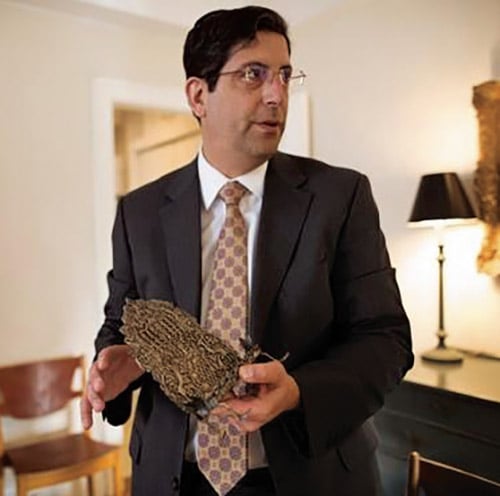


To many Americans, Judaism is rooted in the snowy shtetls of Poland, or perhaps even in the cities of Germany, Kiev or Budapest. In the mind of the average American, Judaism is rarely associated with a wider scope of history or geography, yet it should be. Jewish history is as much about the people as it is about the experiences they lived through and the places from where they came. This year, right before Chanukah, a selection of over 350 pieces of antique Judaica will be up for auction in Cedarhurst, New York, by J. Greenstein and Co., and each item represents a time and place in history where Jews added to their rituals and traditions based on local customs and habits. Many of the religious practices today are hybrids of biblical law meshed with the rituals and practices of the time and place where they lived. The pieces being auctioned carry stories and lore of a rich history that has enhanced Judaism over the centuries.
Famed antiquities expert and historian, and founder of the auction house, Jonathan Greenstein, talks with pride about the pieces in his collection, as items hail from across the Jewish world: from Poland to Persia, Morocco to Israel. They serve as a testimony to a people spread wide around the world, with a common history, similar practices, struggles and celebrations, but infused by the mannerisms of the societies in which each lived.
A featured piece of the auction is an 1880’s Sefer Torah inscribed with Sephardic-style handwriting, crafted by a Bukharian Jewish scribe. Hailing from the central part of the Asian continent, the culture of the Bukharian Jews resembles a cross between Russian-speaking Ashkenazi Jews and those from Persia. In the Sefer Torah, you can see a similar mixing of cultures. A plain wooden scroll reminiscent of those found on a Russian Torah is wrapped with parchment resembling Sephardic handwriting and heritage. Imagine the subtleties of cross-cultural interactions that are found in other objects in this collection.
A Woman’s Sabbath Cap is an example of adding beauty to a life of mitzvah keeping. Jewish women would “cover their hair within the presence of men other than their immediate family,” explained Greenstein. “It was a custom among wealthy women in Poland to wear these very elaborate caps.” Placing a beautiful hat on their head was not only sanctifying themselves by keeping Jewish law, but it also allowed them to maintain their beauty and modesty.
Another item that stands out is a Velvet Torah Tik (covering) made in Persia in the early 1900s (with the original Torah included). The velvet glimmers with a rose-like color, which is complemented by the ornate gold and silver designs. When the Tik is opened, the top is plated with brass with a golden shine. The shape of the top of the Tik is clearly influenced by Persian architecture, almost like the arches in some of the mosques in Isfahan. Again, there are cross-cultural interactions, where Jews both contributed to and accepted elements from the cultures by which they were surrounded. This is a museum-quality piece, and would be at home in the hands of a private collector. Greenstein explained, “The Persian Sefer Torah was actually found in the Zaleznik estate. It was very surprising to find such a piece in a collection of a very Ashkenazi family. I imagine Dr. Zaleznik wanted to have an example of each discipline with every heritage represented.” In fact, it is due to this very wide span of interests of the Zaleznik family that J. Greenstein and Co. is able to auction such a diverse group of items this December.
Mr. Greenstein has a retail location in Long Island’s Five Towns, where he sells unique and sometimes one-of-a-kind Jewish pieces. Additionally, he hosts auctions multiple times a year.










